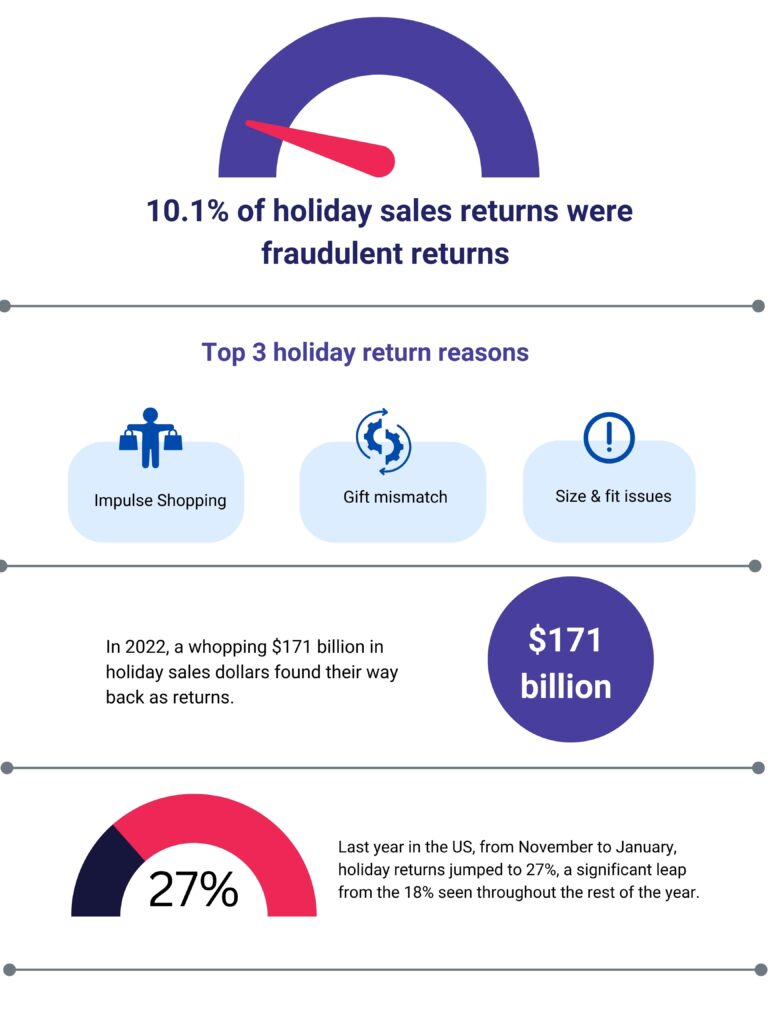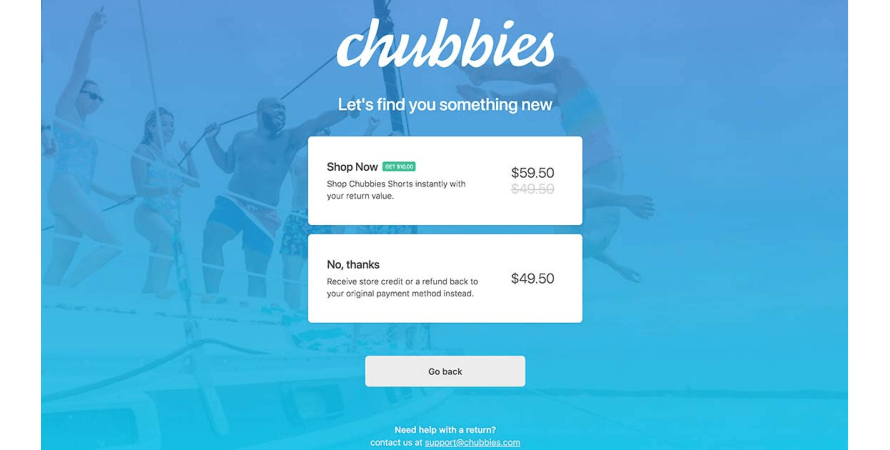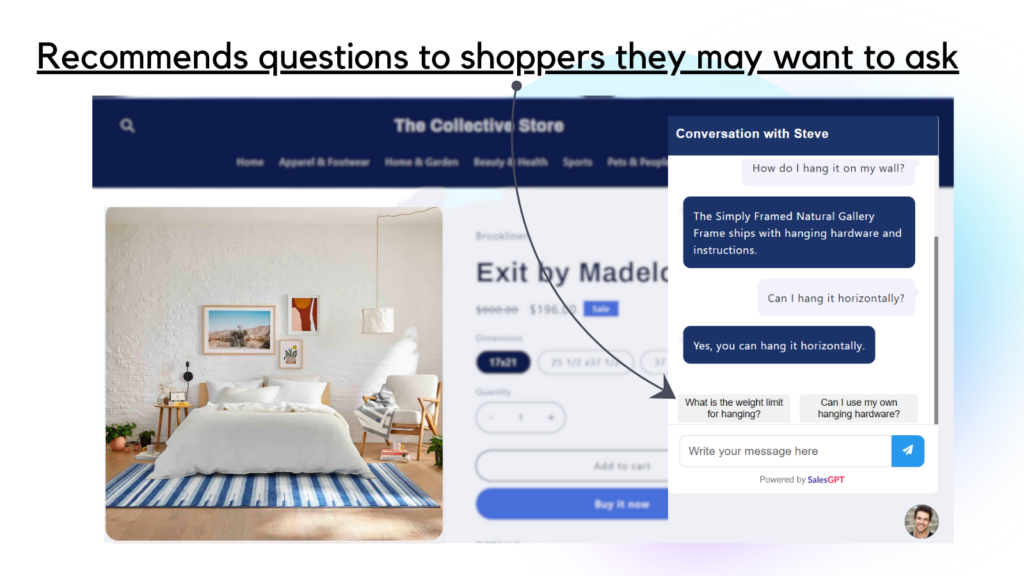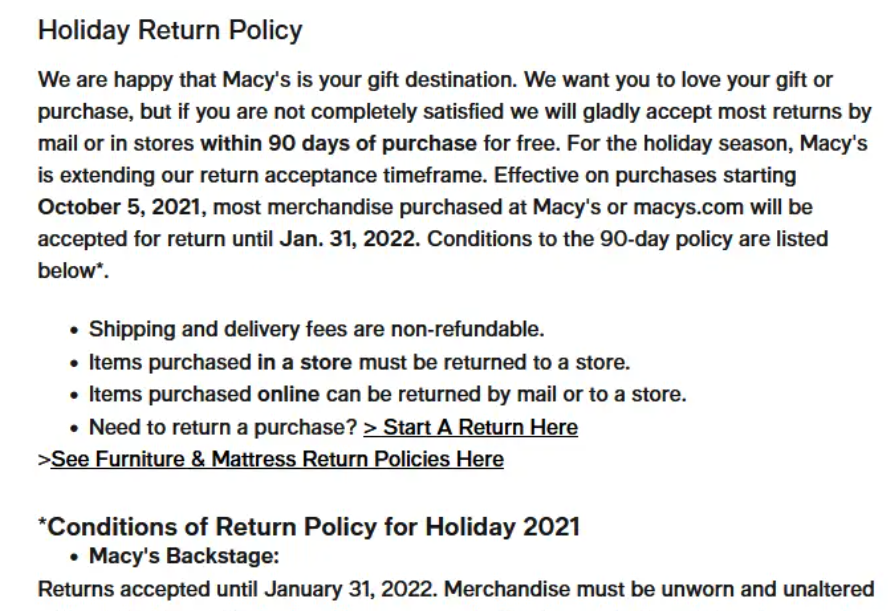\’Tis the season, and the holiday spirit is in full swing, bringing a surge in sales for eCommerce businesses. Whether customers are treating themselves or searching for that perfect gift, the uptick in purchases also brings a challenge – holiday returns. Let\’s take a closer look at some eye-opening figures to grasp the impact of these holiday returns on eCommerce businesses:
- Last year in the US, from November to January, holiday returns jumped to 27%, a significant leap from the 18% seen throughout the rest of the year.
- In 2022, a whopping $171 billion in holiday sales dollars found their way back as returns.
- 10.1% of holiday sales returns were fraudulent returns
- Retailers faced a substantial loss of $17.3 billion due to fraudulent holiday returns.
- Acknowledging the potential strain, 44% hired additional staff specifically to navigate the complexities of holiday returns.
These numbers paint a clear picture of the looming threat that holiday returns pose to online brands. Beyond the logistics of handling these returns, brands also grapple with the financial impact on their bottom line. If not managed effectively, these returns can strain inventory levels, bring a spike in operational costs, and take a toll on overall profitability.

Understanding Holiday Returns
Let\’s break down the buzz around holiday returns. Returns are a natural part of running an online store, but here\’s the deal: returns from January to October are way less compared to the holiday months from November to January. Why? Well, it\’s simple math – holiday season equals high sales, and high sales often mean more returns. That\’s what we call holiday returns. Here are some common reasons behind them:
Impulse Shopping
During the holidays, everyone gets a bit caught up in the excitement of sales on different websites. This leads to impulse buys as people don\’t want to miss out on a good deal. But once the holiday craze settles, shoppers might feel a bit of regret, commonly known as \”buyer’s remorse.\” This regret often results in returning items bought on impulse.
Gift Mismatch
Another big reason for holiday returns is when the gift someone picks doesn\’t quite match the receiver\’s taste. Even with good intentions, choosing the perfect gift is tricky, and sometimes, recipients want something different. So, they return or exchange the gift to get what suits them better.
Size and Fit Issues
When it comes to buying gifts like clothes, shoes, or accessories, there\’s always a risk of getting the wrong size or fit. Without the recipient trying it on beforehand, it\’s tough to get it just right. This uncertainty often leads to returns, especially if the size or fit isn\’t what the person needs.
Now let us look some of the smartest ways to reduce holiday returns in 2023:
Incentivize exchanges over returns

Encouraging customers to exchange instead of returning is a great way to transform returns into an opportunity for your brand. Think of it like this – you wanted blue, got red? Don’t worry, let’s get you that blue beauty instead!
Incentive customers with store credits, a certain percentage of the product value or some discounted rates for an exchange instead of a return. And here\’s a bonus – add some loyalty rewards to make exchanges even better. It\’s an easy way to keep your customers happy and make the whole exchange thing a win-win!
Offer personalized shopping experience

Imagine having your own shopping buddy whenever you go online. That\’s the magic of personalized assistance. When brands use tools like chatbots or real people to help you choose, it makes a real difference in how you decide what to buy. This also reduces chances of returns as shoppers are likely to make informed decisions before making a purchase.
SalesGPT is an AI-powered sales rep for online stores that helps brands boost sales, converting curious shoppers into buyers. It answers all product queries of shoppers, guide them through their purchase, and even throws in some suggestions based on what your shoppers like.
Clear and transparent return policies

Clear return policies are like a map for customers navigating the shopping journey. Think about it – when return policies are crystal clear, it takes the guesswork out of the equation, making it easier for shoppers to understand the rules of the game. To make these policies transparent and shopper-friendly, keep it simple and straightforward. Use plain language that everyone can grasp without needing a dictionary.
And here\’s the key – communicate these policies like you\’re talking to a friend, not a legal document. Let customers know what to expect in a way that feels like an honest chat, so there are no surprises down the road. It\’s all about making the return process a breeze and keeping the trust intact between brands and their customers.
Know more about how to write a return policy for your store here.
Detailed descriptions and Images

Last but not the least, the secret sauce to happy shoppers and fewer returns lies in nailing those product descriptions and images. Think about it – when the product details are spot-on, there\’s less room for surprises. High-quality images and detailed descriptions make it crystal clear what shoppers are getting. It\’s like bringing the store to their screens. And let\’s not forget those specifications – the more, the merrier. When customers have all the info they need, they\’re less likely to send things back. So, it\’s not just about selling; it\’s about making sure customers know exactly what they\’re getting, right from the get-go.
Bonus Tip: Invest in a returns solution that not only manages returns but reduces them too!
A returns solution that can reduce returns for your brand can be a boon for your business, especially during the holiday season.
EcoReturns is an AI-powered eCommerce returns solution that helps brands reduce returns by an average of 30%. It also flags risky orders and prevents fraudulent returns by 60%.


